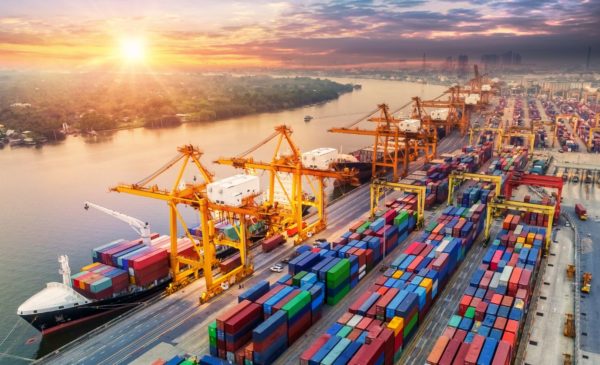Combatting Coronavirus Chaos
Apr 16, 2020
Scroll to find out more
Apr 16, 2020
Scroll to find out more

From massive declines in available air freight, to empty supermarket shelves, to closed factories – the supply chain is in massive flux right now, so we’ve put together a critical list of the capacity crunches and what you can do to mitigate them and keep your own products moving.
With passenger air demand collapsing massively across most key routes in the space of a month and more flight restrictions being announced than re-openings, air freight capacity has been slashed.
Major airlines, such as easyjet, have grounded their entire fleet and China continues to restrict international flights, fearing a second wave of infections, leaving just one flight per airline, per week to a single given country, meaning hundreds of flights each week, not thousands, which is equivalent to a 90% drop in air capacity. Globally, the final week of March saw 55% less commercial flights in the sky than in the same period in 2019.
This has pushed rates up for air transportation massively since the start of the crisis, particularly into and out of Asia.
According to the price monitoring undertaken by TAC Index, prices per kilo from Shanghai to North America and Europe in late March reached $6.59 per kg and $5.15 per kg, respectively, representing increases of 15% and 25.9% on the prior week. There have also been big jumps on North American-European routes.
The solution: If you can hang on just a little longer, it might be prudent to do so. The rate of inflation appears to be turning as demand cools off and airlines put some passenger aircraft back to work hauling air freight only. Both IAG and American announced additional capacity in the last few days. If that isn’t possible, then express capacity is available on some ocean and rail routes, which we can help you identify and utilise. You should also examine alternative suppliers who are very near to your key facilities.
You can check on the status of numerous air cargo operations through IATA.
Trucking rates have been soaring in the US, while Europe has been impacted by driver shortages, reluctance by many truckers to enter areas with major infections and border delays as different countries adopt different shutdown policies. In particular, Austrian, Eastern Europe and Swiss borders have been experiencing significant delays recently. The opening of new ‘green lanes’ in the EU that offer express movement should help to ease this but there are still numerous routes where there isn’t enough return cargo and this is creating high rates in some areas, such as into the UK.
In the US, Freightwaves’ Outbound Tender Volume Index, which approximates truck freight traffic, reached a record high in March and its outbound tender reject index moved up to a point higher than at any point in 2019 and to-date in 2020 in the last week of March. This has put carriers in the driving seat when it comes to pricing. However, this likely the peak, with shutdowns becoming more
widespread and the peak of consumers and businesses stocking up behind us.
The solution: In Europe, intermodal rail freight is a potential alternative means of transportation. Passenger rail movements have been reduced, so there is added space for cargo, which also helps reduce the border delays. In the US, prices and availability should be about to turn as the durable goods market falls off and 75% of Americans are now in lockdown. Furthermore trucks are now able to move more efficiently in many affected areas due to reduced congestion.
Blank sailings have shot up at an incredible rate as carriers try to anticipate changing demand patterns. In the last week, ship owners have announced more than 45 blank sailings as a result of the pandemic, according to Sea-Intelligence Consulting. The result of this and changing patterns of transportation is that much of the world’s usually finely tuned system is out of whack and containers are not where they normally are. In particular, there is a shortage of containers in Europe, due to the cuts in sailings from Asia-Pacific.
The solution: You need to be monitoring the situation and be agile enough to respond through the right business intelligence. Contact us to find alternatives if you have been caught out and sign up to our regular briefing to be immediately informed of the latest trends.
Massive uncertainty and lockdowns are causing production to go offline in an unforeseeable way prior to this crisis. This is causing seizures in manufacturing as component manufacturers are forced to shutdown or pare down production. This has been most notable in China, given its huge manufacturing base and its integration into global supply chains, but can now be seen in a variety of global locations.
The solution: Evaluate at-risk SKUs and research prioritise SKUs according to the likelihood of stocking out and the potential revenue loss this would cause. Look for alternative manufacturers, preferably nearer to the destination market and think about diversifying even if you don’t feel at risk at this stage.
The way this disease is moving across borders and the different ways it is being countered means that there are now stockpiles building up as export bans, blank sailings and changing demand patterns put movements on ice.
As demand is beginning to fade with panic buying subsiding and both business and consumers hunkering down both in the immediate term from lockdowns and longer due to the economic shock, warehouse space is set to be at a premium.
The solution: Start by thoroughly checking inventory and matching it to needs now, both in-transit and in-stock. Aim to hold stock at origin for now where possible rather than shipping it in the very near future and prioritise shipping speed based on meeting real demand and needs.
Download our COVID-19 Supply Chain Disruption Strategy: The Retailers Guide to Navigating a Global Pandemic to learn more about how to effectively plan inventory understand priorities.
It is not all shortages, in some places there are surfeits. Oil and the downstream supply chain are the site of the biggest global glut right now. Upped production from both within and outside OPEC have created more supply just as demand craters. This is good news for most operators in the supply chain due to lower costs for petrochemical derivative products and, principally, from lowered fuel costs. Although workforces in several key oil production areas may find themselves cut down soon, the fall in demand is set to be unprecedented and it doesn’t seem like this will reverse any time soon.
.png)
Learn how leading businesses are using agile supply chain management and prioritisation to minimise stock outs and lost revenue with our in-depth strategy guide.
Discover how you can:

The rapid spread of COVID-19 across the world has made it abundantly clear that...

As COVID-19 continues to shut impact huge sections of the global economy, we hav...

It can be tough to keep products moving across the supply chain at the best of t...